Technical Focus: Gas Fireplaces and Gas Logs
Gas fireplaces are popular with homeowners. According to the National Association of REALTORS® (NAR), 40% of homebuyers would be willing to pay extra for a home with a fireplace. The National Association of Home Builders (NAHB) reports that 49% of respondents to a survey ranked gas fireplaces as essential or desirable as a decorative feature. Gas fireplaces are appearing in one of every two new homes built in the United States. Gas fireplaces are now slightly more popular than wood-burning fireplaces with consumers. We expect that trend to continue, as people emphasize speed, convenience and, in some cases, modern style.
Although these may more properly be called decorative gas appliances, the term gas fireplace is broadly used and understood by homeowners. Many gas fireplaces do provide heat for rooms. Fireplaces with heat circulators and direct-vent fireplaces are more likely to be heating appliances. They may be rated as space heaters as a result. The heat circulators can be convection or fan-forced. The burner systems can be controlled by a pilot or electronic ignition system.
Types of Gas Fireplaces
There are three basic types of gas fireplaces:
- Inserts are designed to fit inside existing masonry wood-burning fireplaces. An insert can be a full gas fireplace or a gas log.
- Factory-built fireplaces or “zero-clearance” fireplaces are typically built-in and may have a chimney or a sidewall venting system. These units may be direct-vent, taking combustion air from outdoors.
- Freestanding units are reminiscent of wood stoves.
In some areas, unvented gas fireplaces are or were permitted. We will not address these controversial units in this article.
More Like A Gas Space Heater Than A Wood- Burning Fireplace
Gas fireplaces and gas logs may be installed in wood-burning fireplaces. However, gas fireplaces have more in common with gas furnaces and space heaters than with wood-burning fireplaces. Gas fireplaces designed to fit into masonry fireplaces are often referred to as fireplace inserts.
Flame Color
Gas flames are generally blue on heating appliances, suggesting relatively complete combustion. Gas fireplaces and logs typically have intentionally yellow flames to mimic the flame from wood fires. The yellow color may be induced by flame impingement on solid materials and does not necessarily indicate incomplete combustion.
Glass Doors
Some systems have glass doors that cannot be opened. Others have glass doors that can be kept open or closed. Consumer Reports indicated that 80% of all gas fireplaces sold in 2017 had fixed glass panels.
Listed, Certified or Approved
As when inspecting all gas appliances, home inspectors should be looking for a label that suggests that the system has been tested by a recognized agency.
Combustion Air
Combustion air for these devices may be taken from house air or from outside.
Combustible Clearances
Typically, combustible clearances are smaller than for wood-burning fireplaces and are determined by the manufacturer’s instructions on the label of the units. Combustible clearances around the openings of fireplaces often can be smaller than that required for wood-burning fireplaces.
Location Restrictions
Generally speaking, gas fireplaces are not permitted in bathrooms unless they are direct-vent systems.
In some jurisdictions, gas fireplaces are not permitted in bedrooms or in sitting rooms unless they are direct-vent systems or specifically approved for bedroom use.
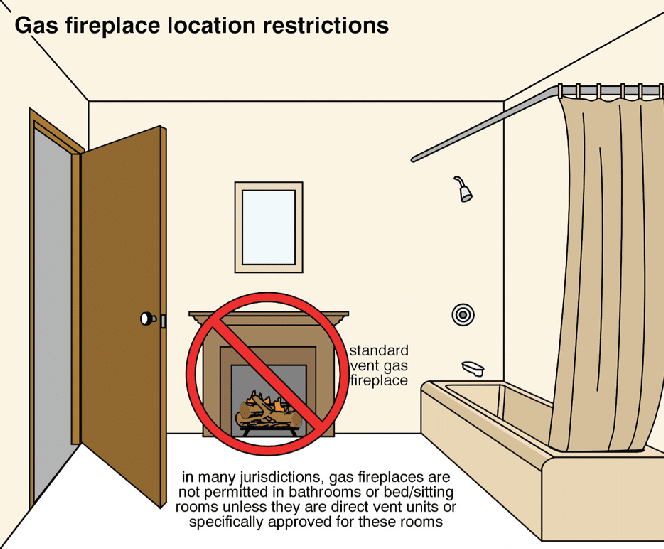
Venting
Vented gas fireplaces and gas logs must be vented, either through a chimney or through a direct-vent system. Often, direct-vent systems go out through a side wall rather than up through the roof. This reduces installation costs.
Gas Logs
Gas logs may be installed in some existing wood-burning fireplaces. Some wood-burning fireplaces that have metal fire boxes or glass doors may not be suitable for gas log inserts.
Damper Sealed Open
Where gas logs are installed in an existing fireplace, the fireplace damper must be permanently opened or removed so that the exhaust can go up the chimney. The required vent area is specific to manufacturers and BTU-per-hour ratings.
Gas logs must be rated for use in a masonry fireplace. The fireplace itself must be a noncombustible unit properly designed for burning wood.
Ignition Systems
Gas fireplaces and gas logs can have either electronic ignition or continuous pilots.
Remote Controls
Remote controls are available to turn the fireplace on and off, and to control circulating fans. Fans may be manual or thermostatically controlled. Some systems have modulating burners with variable flame levels.
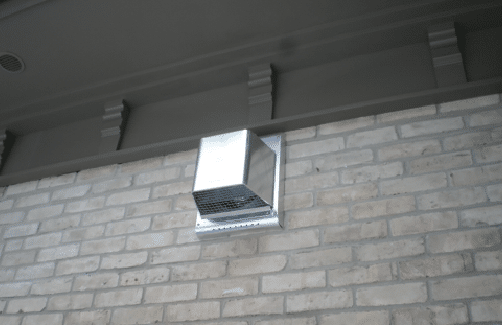
Venting Options
These systems can be vented through a conventional B-vent, or can be direct-vent systems with special venting. Typical requirements for B-vents apply—clearance from combustibles, height, offsets, termination, insulation shields and fire stops, for example. Also, single-wall metal liners in masonry chimneys are allowed in some areas.
Some systems with B-vents have an automatic vent damper, similar to the efficiency upgrades on gas furnaces. These vent dampers automatically open when the fireplace comes on and they close when the fireplace is shut off. Some systems are power-vented. Power-vented systems can be sidewall-vented.
Direct-Vent Systems with Outside Combustion Air
Direct-vent systems have an integral outside air intake. Those with conventional venting systems also may have outside air provision. This is an option on some systems.
Combustible Clearances for Vents
Combustible clearance requirements for vents vary with manufacturer. In many cases, the required clearance is 1 inch or less.
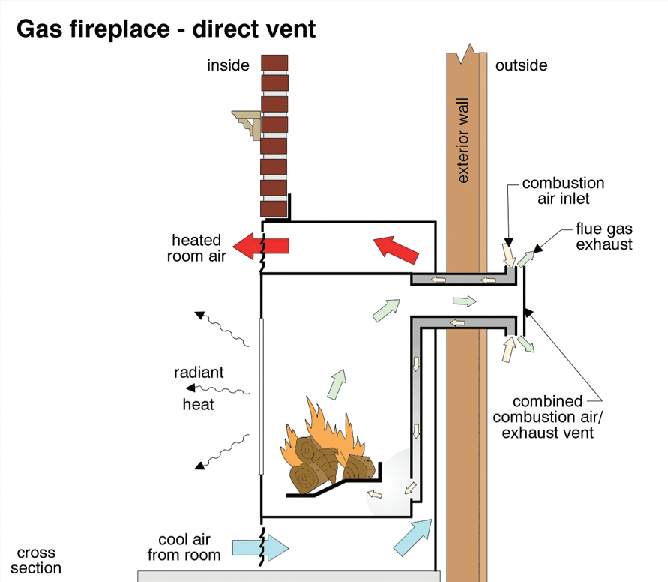
Direct Venting with No Fan
Most central furnaces that are direct-vent systems use an induced draft fan to remove exhaust products from the home. Some direct-vent gas fireplaces rely simply on convection. There is no fan to induce exhaust gases to leave the building. Similarly, there is no fan to draw combustion air in. This all takes place on a convective basis.
Heat Exchangers Built In
Some gas fireplaces contain a heat exchanger to help transfer heat into the house air. Heat is transferred into the house by a combination of radiation and convection. Gas fireplaces that act as room heaters claim efficiencies of 75% or even higher.
Typical Combustible Clearances
A gas fireplace might require a 1-inch combustible clearance behind it, 6 inches at the sides, 36 inches out in front and 36 inches above. The required clearance to a 6-inch-wide mantel shelf above the fireplace can be as little as 4 inches or as much as 16 inches. Watch for evidence of overheating above the firebox. Hearth extensions may or may not be required.
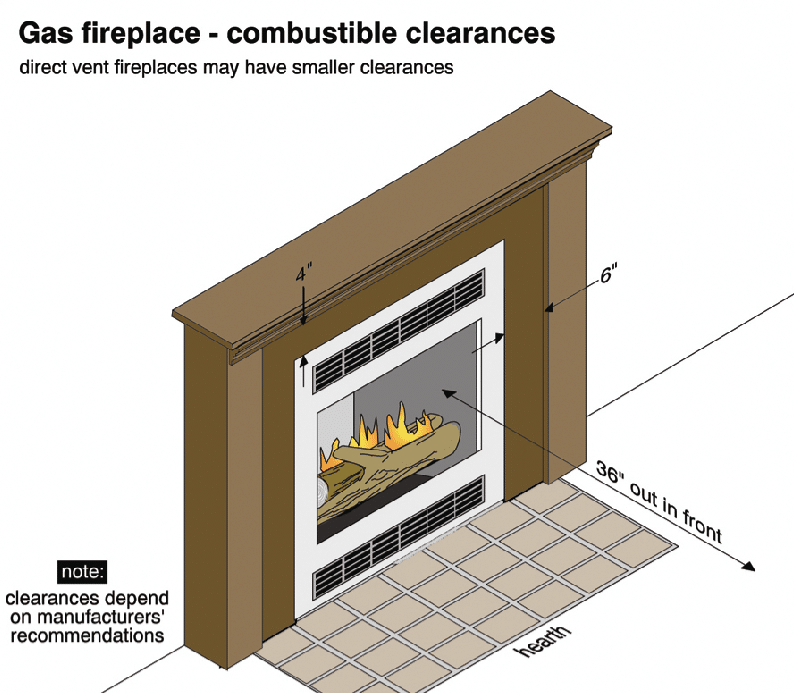
Heating Capacity
Gas fireplaces often have input rates of 5,000-40,000 BTU/hour. Outputs may be 75% of this, although some direct-vent units claim to be more than 90% efficient. Care should be taken with efficiency numbers, because there is more than one way to calculate these numbers. Steady-state efficiencies tend to be higher than seasonal or Annual Fuel Utilization Efficiencies.
Vented gas logs put into an existing masonry fireplace can have ratings up to 90,000 BTU/hour. These units are typically the least efficient gas fireplace systems.
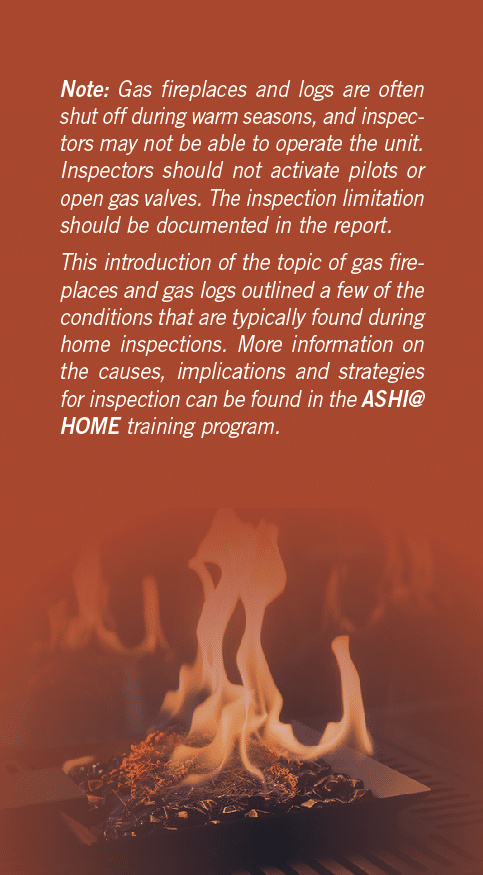
Fireplace Screens
Effective January 1, 2015, regulations require that a fireplace barrier (screen) must be sold with every glass-fronted gas fireplace and gas stove. The goal is to prevent children and pets from burning themselves by touching the hot glass. The glass temperature can exceed 500° F and can remain dangerously hot for an hour after the unit is shut off.
Attachable screens are available for some units, provided by the manufacturer or third parties. After-market units need to be approved by the manufacturer. Many manufacturers are focused on providing low-visibility screens that do not visually detract from the fireplace.
Conventional freestanding fireplace screens commonly used for wood-burning fireplaces are effective and recommended for older units. Freestanding safety gates are also acceptable.
All of the standard problems with gas appliances apply. Here are some issues specific to gas fireplaces and logs:
- Not suitable for use in a bedroom or bathroom: Where you see a gas fireplace in a bedroom or bathroom, it should be a direct-vent system or approved for use in bedrooms or bathrooms. This only applies to some jurisdictions—you will have to check with your local authorities.
- Damper in existing fireplace not fixed open: In places where there are vented gas logs in a masonry fireplace or in an approved factory-built fireplace, the damper should be permanently fixed open. Damper clamps are often provided with the log set so they can be attached to the damper.
- Glass door problem: Some direct-vent natural gas fireplaces with permanently sealed glass fronts have had problems. There have been some cases of gases accumulating inside the firebox and exploding, shattering the glass doors.
- Soot: Soot indicates incomplete combustion and may suggest inadequate combustion air. Home inspectors should recommend further evaluation by a specialist.
Thank you to Roger Hankey for his assistance and contributions. We are looking forward to working with the ASHI Technical Review Committee to review these articles prior to publication.
To Read the Full Article
ASHI offers its members unparalleled resources to advance their careers. ASHI offers training for inspectors at all levels of knowledge and experience, including resources about all major home systems. Members benefit from a vast network of experienced professionals, providing a community for mentorship and knowledge sharing..
In this Issue

FIND A HOME
INSPECTOR
Professional Networking
Grow your professional network, find a mentor, network with the best, and best part of the community that’s making home inspection better every day.
